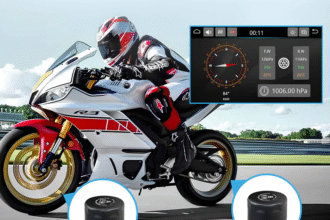Introduction to Mecanum Drive Template Odometry VEX V5
Mecanum Drive Template Odometry VEX V5 systems have revolutionized the way robots maneuver, offering unparalleled agility and precision. But to truly harness their capabilities, you need a reliable method for tracking movement—this is where template odometry comes into play. With VEX V5 technology at your fingertips, optimizing mecanum drive with template odometry can elevate your robotics projects to new heights.
Imagine a robot that glides smoothly in any direction without losing its bearings. That’s the promise of integrating optimized mecanum drive technology with effective odometry solutions. Whether you’re a seasoned engineer or just starting out in robotics, understanding how this synergy works can provide significant advantages in your designs.
In this article, we’ll dive deep into what makes template odometry essential for maximizing the potential of mecanum drives on the VEX V5 platform. Get ready to transform your robotic creations and enhance their operational efficiency!
Understanding Template Odometry for Mecanum Drive
Template odometry is a method used to estimate the position and orientation of a robot. For Mecanum drive systems, this technique becomes crucial due to their unique wheel configuration.
Each wheel can move independently, allowing for agile maneuverability. This independence introduces complexity in tracking movement accurately. Template odometry simplifies this by leveraging pre-defined mathematical models that account for each wheel’s motion.
By using encoders mounted on the wheels, data is collected as the robot moves. This data feeds into algorithms that calculate changes in position over time. These calculations help maintain accurate localization within an environment.
Understanding these principles enables developers to refine their robots’ navigation capabilities significantly. It ensures that even with intricate movements, your Mecanum drive remains precise and reliable during operation.
Step-by-Step Guide to Implementing Template Odometry on VEX V5
To implement template odometry on your VEX V5 with a mecanum drive, start by gathering essential components. You’ll need the robot’s wheels, sensors, and a microcontroller.
Next, install the necessary libraries in your programming environment. This will help you access functions crucial for accurate movement tracking.
Once that’s done, configure your encoders on each wheel to collect data regarding distance traveled. Calibrate them properly for precise readings.
Now it’s time to integrate gyroscope input into your code. This aids in measuring rotation and direction changes effectively.
Create a function that calculates both x and y coordinates based on encoder values. Don’t forget to include adjustments for any slippage or drift during movement.
Test the system extensively in various scenarios. Tweak parameters as needed until you achieve optimal performance from the mecanum drive setup.
Common Challenges and Troubleshooting Tips
When working with mecanum drive template odometry on VEX V5, several challenges may arise. One common issue is inaccurate positioning due to wheel slippage or uneven surfaces. This can lead to erratic movement and difficulty in navigating.
Another challenge involves sensor calibration. If the sensors aren’t properly calibrated, your robot’s measurements will be off. Taking the time to ensure accurate sensor setups can save a lot of headaches later on.
Battery power fluctuations can also play a role in performance inconsistencies. Regularly checking battery levels and ensuring optimal power supply is essential for reliable operation.
Additionally, coding errors might creep into your implementation. Debugging code step-by-step helps identify issues quickly and ensures smooth functionality.
Make sure you have updated firmware versions for both the motors and sensors in use as outdated software could hinder performance significantly.
Real-World Applications of Optimized Mecanum Drive with Template Odometry
Optimized Mecanum Drive with Template Odometry has found its place in various real-world applications. Robotics competitions often showcase this technology, enabling teams to maneuver quickly and efficiently during matches.
In industrial settings, Mecanum drive systems are used for automated guided vehicles (AGVs). Their unique wheel design allows them to navigate tight spaces effortlessly. This capability increases productivity in warehouses and manufacturing plants.
Furthermore, service robots equipped with Mecanum drives can easily move through crowded environments. Whether delivering packages or assisting customers, they provide significant flexibility while maintaining precise navigation.
Research institutions also utilize optimized configurations for experimental robots. The adaptability of the mecanum drive system supports innovative designs and testing scenarios that enhance robotic mobility.
Moreover, educational platforms leverage these technologies to teach students about advanced robotics principles. Hands-on experience with such systems fosters a deeper understanding of motion control and programming skills among aspiring engineers.
Future Developments and Improvements for Mecanum Drive Technology
The future of Mecanum drive technology is bright, with ongoing research and innovation in various fields. One area ripe for improvement is the integration of advanced sensors. Enhanced sensor technology can provide more accurate feedback for odometry systems, thus improving navigation precision.
Another exciting development is the application of artificial intelligence. Machine learning algorithms could enable robots to adapt their movements based on real-time environmental data, optimizing performance dynamically.
Moreover, advancements in materials science may lead to lighter and more durable wheels, enhancing overall efficiency. This would allow VEX V5 robots equipped with Mecanum drives to carry heavier loads while maintaining agility.
Community collaboration plays a crucial role in evolving this technology. Open-source contributions can foster new ideas and solutions that benefit everyone engaged in robotics education or competitions. These collaborative efforts will certainly shape the next generation of Mecanum drive implementations.
Conclusion
The journey of optimizing Mecanum Drive Template Odometry for VEX V5 is both challenging and rewarding. Mastering this technology not only enhances your robotics projects but also deepens your understanding of advanced movement mechanics.
As you apply the step-by-step guide, anticipate hurdles and use troubleshooting tips to refine your skills. Real-world applications demonstrate the immense potential of optimized systems in various fields, from competitive robotics to industrial automation.
With continuous developments on the horizon, staying informed will keep you ahead in a rapidly evolving landscape. Embrace the learning curve and enjoy every moment as you explore the exciting world of mecanum drive technology with template odometry!
















